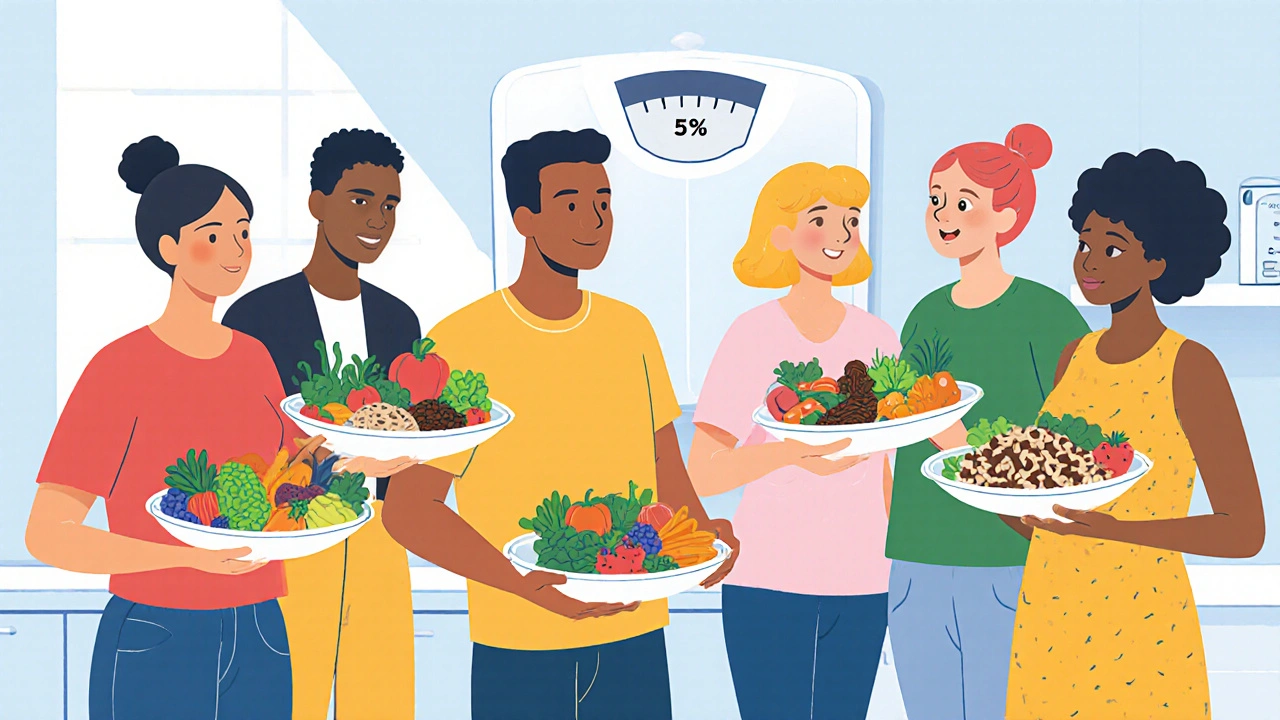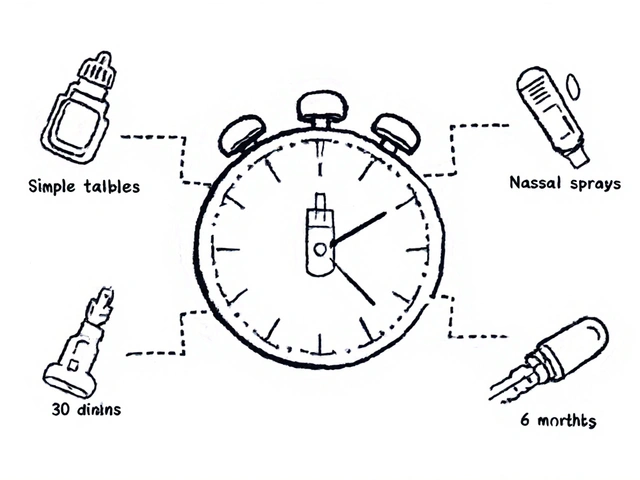Prediabetes Reversal: Lifestyle Changes to Prevent Type 2 Diabetes

- Colin Hurd
- 17 November 2025
- 11 Comments
More than 96 million adults in the U.S. have prediabetes-and most don’t even know it. That’s more than one in three people. The good news? You don’t need medication to turn it around. In fact, the strongest evidence shows that simple, everyday changes can reverse prediabetes and keep type 2 diabetes from ever happening. This isn’t about extreme diets or punishing workouts. It’s about making small, lasting shifts that actually work.
What Prediabetes Really Means
Prediabetes isn’t a warning label-it’s a window of opportunity. Your blood sugar is higher than normal, but not high enough to be called type 2 diabetes. The numbers? A fasting blood glucose between 100 and 125 mg/dL, an HbA1c between 5.7% and 6.4%, or a 2-hour glucose level of 140 to 199 mg/dL after a glucose test. These aren’t just numbers on a lab report. They’re signs your body is struggling to use insulin properly.
Insulin resistance is the root problem. When you carry extra weight-especially around your belly-your cells stop responding well to insulin. Your pancreas works harder to pump out more insulin. Eventually, it burns out. That’s when blood sugar climbs into diabetic range. But here’s the key: this process isn’t inevitable. The lifestyle changes that reverse prediabetes work because they directly target insulin resistance.
The Science Behind Reversal
A 2023 review of studies published in PMC found that people who made lifestyle changes were 18% more likely to get their blood sugar back to normal than those who didn’t. That might sound small, but it means that for every six people who stick with these changes, one will avoid type 2 diabetes entirely. The CDC’s National Diabetes Prevention Program showed even better results: people who lost 5% to 7% of their body weight and got 150 minutes of walking or similar activity each week cut their risk of diabetes by 58%.
And here’s something surprising: you don’t even need to lose weight to reverse prediabetes. A study in Nature Medicine found that people who normalized their blood sugar without losing any weight still slashed their future diabetes risk by 70% over 10 years. What changed? Their belly fat. Visceral fat-the kind that wraps around your organs-is the real culprit. It releases inflammatory chemicals that mess with insulin. When that fat shrinks, even if your scale doesn’t budge, your metabolism improves.
Diet: Eat to Lower Blood Sugar
You don’t need to cut out carbs completely. You just need to choose smarter ones. Refined carbs-white bread, white rice, pastries, sugary drinks-spike blood sugar fast. They’re the main drivers of insulin resistance.
- Swap white rice for brown rice, quinoa, or farro.
- Replace sugary cereal with oatmeal topped with berries.
- Drink water, unsweetened tea, or sparkling water instead of soda or juice.
- Fill half your plate with non-starchy vegetables: broccoli, spinach, peppers, zucchini, kale.
- Choose legumes-beans, lentils, chickpeas-as protein sources. They’re high in fiber and digest slowly, keeping blood sugar steady.
- Limit processed meats like bacon, sausage, and deli meats. They’re linked to higher diabetes risk.
One simple rule: if your plate is mostly beige-white bread, pasta, potatoes, rice, chicken breast-add color. Green vegetables, red peppers, purple cabbage, orange carrots. Color means nutrients and fiber, which slow sugar absorption.
Movement: Move More, Sit Less
Exercise isn’t just about burning calories. It’s about making your muscles more sensitive to insulin. When you move, your muscles grab glucose from your blood without needing insulin. That’s huge.
You don’t need to run a marathon. Aim for 30 minutes of brisk walking five days a week. That’s 150 minutes total. Break it into 10-minute walks if that’s easier. Take the stairs. Park farther away. Stand up every hour if you sit at a desk. Research shows that even short bursts of activity after meals help lower blood sugar spikes.
Strength training matters too. Two days a week of lifting weights, using resistance bands, or doing bodyweight exercises (squats, push-ups, lunges) builds muscle. More muscle means your body can handle more glucose. It’s like adding more parking spots for sugar in your cells.
Weight Loss: Focus on Fat, Not Just the Scale
Losing 5% to 7% of your body weight is the CDC’s target. For someone who weighs 200 pounds, that’s 10 to 14 pounds. That sounds manageable. But don’t get stuck on the scale. The real goal is reducing visceral fat.
Two people can weigh the same and have completely different metabolic health. One has a soft belly and high liver fat-high risk. The other has a lean waist and fat stored under the skin-much lower risk. That’s why waist measurement matters more than weight. For men, aim for under 40 inches. For women, under 35 inches.
If you’re struggling to lose weight, don’t give up. Blood sugar improvement can happen even with modest weight gain, as long as you’re eating well and moving more. The goal is metabolic health, not just a number on the scale.
Why Most People Fail-and How to Succeed
Most diets fail because they’re temporary. You don’t need a diet. You need a new way of eating and living. The CDC’s Diabetes Prevention Program works because it’s not about perfection. It’s about consistency.
Here’s what actually works:
- Start small. Pick one change: swap soda for water, or walk after dinner. Master that before adding another.
- Track progress with your doctor-not just weight, but HbA1c every 3 to 6 months.
- Find support. Join a CDC-recognized program. Many are covered by insurance, including Medicare. They offer coaching, group support, and tools to stay on track.
- Be patient. It takes months to reverse insulin resistance. Don’t expect overnight results.
- Don’t go it alone. Talk to your doctor before making big changes, especially if you have other health conditions.
And remember: this isn’t about being perfect. It’s about being consistent. Miss a workout? Eat a slice of cake? That’s fine. Just get back on track the next day. Progress, not perfection, is what reverses prediabetes.
What About Medications?
Some medications-like metformin, GLP-1 agonists, or alpha-glucosidase inhibitors-can help reverse prediabetes. Studies show they work, sometimes better than lifestyle changes alone. But here’s the catch: they don’t fix the root cause. They manage symptoms. And they come with side effects: nausea, diarrhea, or even rare but serious risks.
Lifestyle changes don’t just lower blood sugar. They improve blood pressure, cholesterol, sleep, energy, and mood. They reduce inflammation. They lower your risk of heart disease, stroke, and kidney problems-not just diabetes. That’s why experts agree: lifestyle should always come first.
If your doctor suggests medication, that’s fine. But don’t see it as a replacement for change. See it as a tool to help you while you build healthier habits.
Real People, Real Results
One woman, 58, was diagnosed with prediabetes after her annual checkup. Her HbA1c was 6.2%. She didn’t want pills. She started walking 30 minutes after dinner every day. She swapped white rice for brown rice and added a veggie side to every meal. Six months later, her HbA1c dropped to 5.4%. Normal. She didn’t lose much weight-but her belly fat shrank. Her energy improved. She stopped feeling sluggish after lunch.
A man, 45, was told he had prediabetes and needed to lose 30 pounds. He felt overwhelmed. Instead of a full overhaul, he started by drinking only water. Then he added two days of bodyweight workouts at home. After a year, his HbA1c was 5.6%. He lost 12 pounds, but more importantly, his fasting glucose dropped from 118 to 92. He didn’t need medication. He didn’t need a gym membership. He just changed his routine.
These aren’t rare cases. They’re the norm for people who stick with it.
Next Steps: What to Do Today
You don’t need to wait for a doctor’s appointment. Start now.
- Check your HbA1c if you haven’t in the last year. If you’re over 45, overweight, or have a family history of diabetes, get tested.
- Swap one sugary drink for water today.
- Take a 10-minute walk after your next meal.
- Add one extra serving of vegetables to your dinner tonight.
- Look up a CDC-recognized Diabetes Prevention Program in your area. Many are online and covered by insurance.
Prediabetes isn’t a life sentence. It’s a wake-up call-and one you can answer without pills, surgery, or extreme restrictions. The tools are simple: better food, more movement, less stress, and patience. The outcome? A life free from diabetes, with more energy, better sleep, and longer health.
Can prediabetes be reversed without losing weight?
Yes. Research shows that people can normalize their blood sugar and cut their diabetes risk by 70% even without losing weight. The key is reducing visceral fat-the fat around your organs-through better food choices and regular movement. You don’t need to drop pounds to improve your metabolism.
How long does it take to reverse prediabetes?
Most people see improvements in blood sugar within 3 to 6 months of consistent lifestyle changes. HbA1c levels typically drop noticeably after 3 months. But full reversal can take up to a year or more. The longer you stick with healthy habits, the more stable your results become. Three years of consistent effort offers the strongest protection against future diabetes.
Is walking enough exercise to reverse prediabetes?
Yes, walking is one of the most effective exercises for prediabetes. A brisk 30-minute walk five days a week meets the CDC’s recommendation and improves insulin sensitivity. Adding strength training twice a week helps even more by building muscle, which absorbs more glucose. But walking alone is enough to make a measurable difference.
Does the CDC Diabetes Prevention Program really work?
Yes. The CDC’s program is based on decades of research. Participants who complete the program lose an average of 5.6% of their body weight and cut their diabetes risk by 58%. The program includes coaching, group support, and tools to build lasting habits. Many insurance plans, including Medicare, cover it at little or no cost.
Should I take metformin for prediabetes?
Metformin can help lower blood sugar and reduce diabetes risk by about 30%. But it’s not a substitute for lifestyle changes. Experts recommend starting with diet and exercise first. Metformin may be considered if you’re at very high risk-like if you’re overweight, under 60, and have a history of gestational diabetes. Always talk to your doctor before starting any medication.
Can children reverse prediabetes too?
Absolutely. Children with prediabetes can reverse it with the same principles: more movement, less sugar, and more vegetables. Family involvement is key. Swap sugary snacks for fruit, take walks together, and make meals colorful. Early intervention prevents lifelong health problems. Pediatric endocrinologists often recommend small, sustainable changes over strict diets.
If you’ve been told you have prediabetes, don’t panic. You’re not doomed. You’re not broken. You’re just at a turning point-and you have more power than you think. The next 12 months are your best chance to prevent type 2 diabetes for good. Start today-not tomorrow. Not next week. Today.



Comments
Jenny Lee
Swap soda for water and walk after dinner? Done. Already felt less sluggish by day three.
November 19, 2025 AT 04:29
Evan Brady
People think reversal means losing 30 pounds, but that’s not the point. It’s about fat distribution. Visceral fat is the silent killer - not BMI. I’ve seen clients drop HbA1c from 6.1% to 5.3% without losing a single pound because they started eating fiber-rich legumes and walking after meals. Muscle doesn’t care about scale numbers - it cares about glucose uptake. Build it, feed it, move it. That’s the trifecta.
November 19, 2025 AT 11:02
Saket Sharma
Insulin resistance is a metabolic syndrome, not a lifestyle failure. The pharmaceutical-industrial complex pushes weight loss because it’s monetizable. The real data? Visceral adiposity index > BMI. Stop obsessing over the scale. Focus on waist-to-hip ratio and fasting insulin levels. Also - avoid processed plant oils. They’re worse than sugar.
November 21, 2025 AT 00:36
Shravan Jain
One must question the epistemology of 'lifestyle changes' - is it not merely a euphemism for neoliberal self-blame? The body is not a machine to be optimized. It is a complex, historically embedded system. To reduce prediabetes to 'eat more veggies' is to ignore structural determinants: food deserts, wage slavery, sleep deprivation. The real intervention? Universal healthcare. Not kale.
November 22, 2025 AT 03:42
Brandon Lowi
They don’t want you to know this - but the CDC program? It’s funded by Big Pharma! They want you to think walking and broccoli will save you… so you don’t demand real medicine. Metformin works better. Period. And they hide that stat: 58% reduction? That’s only if you follow their script. Real people? They need drugs. They need insulin sensitizers. Not ‘walks after dinner’ - that’s a distraction. Wake up! This is control.
November 22, 2025 AT 08:26
mithun mohanta
Oh, the *beautiful* irony: a 1500-word treatise on 'simple changes'… while the average American works 60-hour weeks, eats microwave meals, and sleeps 5 hours. You can’t ‘swap white rice’ when you’re choosing between rent and groceries. This is performative wellness for the privileged. The real solution? A living wage. Not another blog post about quinoa.
November 23, 2025 AT 08:11
Alex Boozan
Let me be clear: if you’re still reading this, you’re probably one of the 96 million who don’t know they have prediabetes. And if you think walking is enough, you’re delusional. Your pancreas is screaming. Your liver is fat. Your mitochondria are dying. You need bloodwork. You need a doctor who actually knows what HbA1c means. Not some influencer telling you to eat more ‘colorful plates.’ This isn’t Pinterest. This is your life.
November 24, 2025 AT 00:06
Richard Couron
THEY TOLD YOU TO WALK. THEY TOLD YOU TO EAT VEGGIES. BUT WHO CONTROLS THE FOOD SUPPLY? WHO PUT THE HIGH-FRUCTOSE CORN SYRUP IN EVERYTHING? WHO MADE SUGAR ADDICTIVE? THIS ISN’T ABOUT YOU - IT’S ABOUT CORPORATE GREED. THEY WANT YOU TO THINK YOU’RE BROKEN SO YOU’LL BUY THEIR ‘SOLUTIONS.’ YOU’RE NOT THE PROBLEM - THE SYSTEM IS. STOP BLAMING YOURSELF. ORGANIZE. FIGHT BACK.
November 25, 2025 AT 21:38
Erica Lundy
The notion of 'reversal' implies a return to a prior state - but is metabolic health ever truly reversible, or merely suppressed? The body remembers. Even with normalized HbA1c, epigenetic markers of insulin resistance linger. One may walk, eat greens, and sleep well - yet the latent vulnerability remains. To call this 'cured' is to mistake symptom management for ontological restoration. The true triumph is not in the numbers, but in the daily, quiet act of choosing presence over convenience - a practice as philosophical as it is physiological.
November 26, 2025 AT 11:46
Ram tech
lmao this is so basic. everyone knows this. why is this even a post? walk more eat veg. wow. groundbreaking.
November 27, 2025 AT 19:23
Alexis Paredes Gallego
Wait - so if you don’t lose weight, but your belly fat shrinks… does that mean your organs are secretly doing yoga? And who’s paying the CDC? I’ve seen this before - same script, different year. Next they’ll say sunlight cures cancer. And don’t get me started on ‘colorful plates’ - that’s just a marketing tactic from Whole Foods. They want you to buy organic kale so you forget that your insulin resistance is caused by the 37 chemicals in your tap water. The real reversal? Get off the grid. Move to Alaska. Stop trusting anyone who says ‘just walk more.’
November 29, 2025 AT 18:02